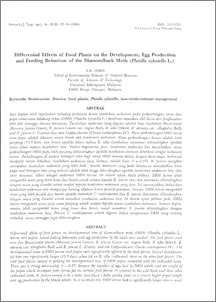Citation
Idris, A. B.
(1998)
Differential Effects of Food Plants on the Development, Egg Production and Feeding Behaviour of the Diamondback Moth (Plutella xylostella L.).
Pertanika Journal of Tropical Agricultural Science, 21 (2).
pp. 93-98.
ISSN 1511-3701
Abstract
Differential effects of food plants on developmental time of diamondback moth (DBM) (Plutella xylostella L.)
laroae and pupae, larval feeding behaviour and egg production by the adult were studied. The food plants used
were five Brassicaceae plants (Brassica juncea Cosson, B. juncea Cosson var. rugose Bally, B. alba Rebenh, B.
oleracea var. alboglabra Bally and B. juncea L. (Czern)) and one Capparidaceae (Cleome rutidosperma DC). The
developmental times ofbDBM laroae and pupae were significantly affected by the food plants. Laroal developmental
time was significantly longer (10.9 days) when fed on B. alba (cultivated) than on the other food plants. The
wild food plants seemed to prolong the developmental time of DBM pupae compared with the cultivated hosts.
There was a strong relationship (r = 0.85) between the numbers of eggs laid by DBM adults and the weight of
the pupae which developed from larvae fed on various food plants. In contrast to the wild hosts and three other
cultivated hosts, B. juncea seemed to be a better food plant ( better quality food) as it caused higher pupal weight
and egg production 1Yy the female adults. In a no-choice test, DBM laroae took a significantly longer time to reachB. juncea (wild and cultivated) than other host plants, indicating that the former had fewer feeding attractants.
DBM larvae spent significantly shorter time to feed on C. rutidosperma and cultivated B. juncea than on other
food plants. In a choice test, DBM larvae took about equal amounts of time to reach each food plant. However,
they spent significantly longer time feeding on B. juncea than on other food plants. The potential of C.
rutidosperma to be used in insecticide-resistant management ofDBM is also discussed.
Download File
![[img]](http://psasir.upm.edu.my/style/images/fileicons/application_pdf.png)  Preview |
|
PDF
Differential_Effects_of_Food_Plants_on_the_Development,_Egg_Production.pdf
Download (3MB)
|
|
Additional Metadata
| Item Type: |
Article
|
| Publisher: |
Universiti Putra Malaysia Press |
| Keywords: |
Brassicaceae, Brassica, food plants, Plutella xylostella, insecticide-resistant management |
| Depositing User: |
Nasirah Abu Samah
|
| Date Deposited: |
01 Dec 2009 00:46 |
| Last Modified: |
27 May 2013 07:10 |
| URI: |
http://psasir.upm.edu.my/id/eprint/3659 |
| Statistic Details: |
View Download Statistic |
Actions (login required)
 |
View Item |

